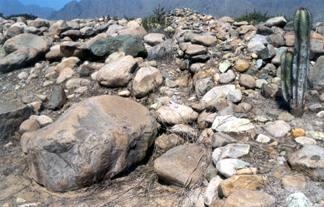 New field studies
of old stone walls in northern Peru indicate that ancient Andeans were good
engineers. Archaeologists have found several stone walls that appear to have
been built to protect communities from landslides and other debris flows, which
are a constant hazard in northern Peru due to frequent earthquakes and heavy
rains from El Niño events in the region.
New field studies
of old stone walls in northern Peru indicate that ancient Andeans were good
engineers. Archaeologists have found several stone walls that appear to have
been built to protect communities from landslides and other debris flows, which
are a constant hazard in northern Peru due to frequent earthquakes and heavy
rains from El Niño events in the region.New field studies at 600- to 2,000-year-old archaeological sites in northern Peru are revealing that ancient Andeans engineered structures to protect themselves from hazardous debris flows. A retention wall runs perpendicular to local drainages, about 1 to 2 kilometers from an ancient village site. Courtesy of Earl Brooks.
Civilizations inhabited the Santa Rita B archaeological site in the Chao Valley in the foothills of the Peruvian Andes from at least 100 B.C. through A.D. 1400. One to 2 kilometers upstream from the site, a 2.5-kilometer-long stone wall runs perpendicular to local drainages, says Earl Brooks, a geoarchaeologist at George Mason University in Fairfax, Va. The “Muralla Pircada,” as the wall is called, is 1 to 2 meters high and up to 5 meters wide, and looks to be a well-designed retention dam, consisting of well-rounded, well-sorted 20- to 30-centimeter cobbles and boulders that match those of nearby streams in both rock type (volcanic) and shape, Brooks and colleagues wrote in a paper published in the July Landslides. The long axes of the stones are gently inclined, and “match the fabric” in nearby streams. “It is a very well-engineered structure that’s purpose and construction techniques are unique,” Brooks says.
Although archaeologists have found a variety of walls near archaeological sites throughout Peru, it was not until Brooks, a geologist by training, examined the Muralla Pircada, that they understood that such walls were for protection against debris flows. Other walls had different purposes, Brooks says. For instance, some sites have circular walls surrounding them like fortresses with more angular stones, frequently with watchtowers and stockpiles of weapons such as slingstones.
Lionel Jackson, a Quaternary geologist with the Geological Survey of Canada in Vancouver, says that he is not surprised that the ancient Peruvians built retention walls to protect their communities. “It is remarkable to see the genius these people put into making a living” in this tough mountainous environment, he says, “building terraces, irrigation systems and entire civilizations in places that most people wouldn’t even consider walking up.”
Northern Peru undergoes “unbelievable mass wasting events,” Jackson says, and evidence shows that ancient civilizations, including the Moche, Chimu and Inca, considered debris flows one of the fundamental forces of nature. Despite these events, the Chao Valley would have been an excellent place to live, Brooks says, as it is close to the Pacific Ocean (a good source for food), and to the Andes (a good source for building materials). Furthermore, the valley marks a confluence of several rivers, which provided water. Archaeological evidence suggests the valley was inhabited for at least 2,000 years.
“There’s good evidence that this retention wall worked” in protecting the sites, Brooks says, including meter-sized boulders that abut the wall. “These people had an amazing understanding of nature,” Jackson says, and they knew how to avoid natural hazards better than many people do today.

